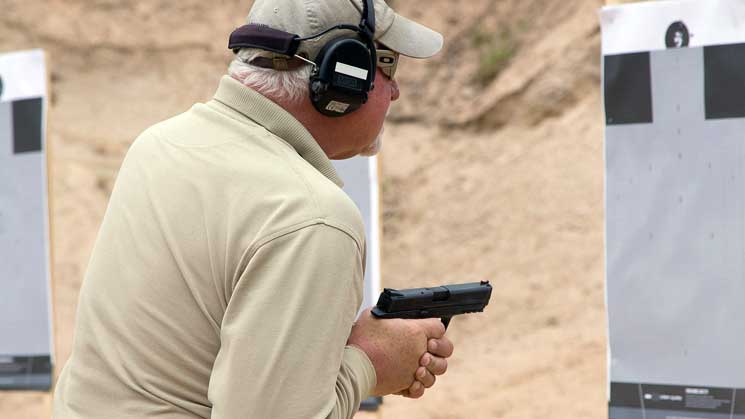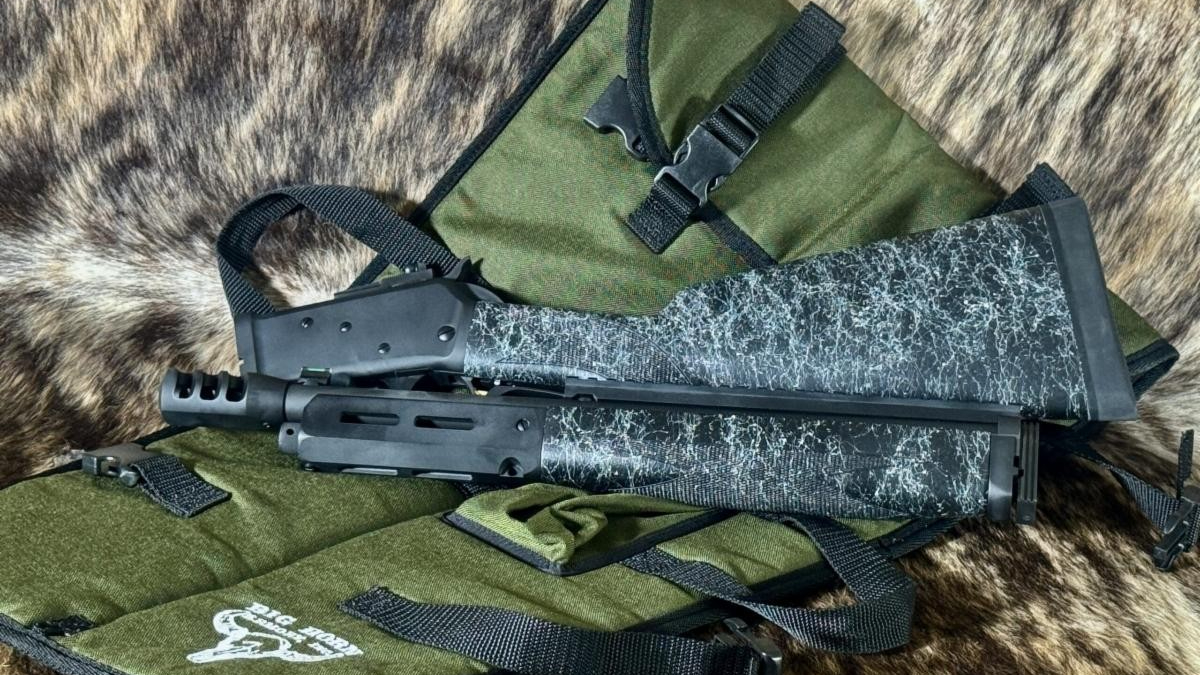
Making the choice to carry a gun involves many smaller decisions. Which gun? Which holster? Open or concealed? Although a tremendous amount of thought goes into gear, many individuals who choose to carry a gun fail to put the same amount of thought into their training. After some basic instruction, a new gun owner will need to practice at regular intervals to stay proficient.
Here, we've compiled a basic five-phase practice routine that will keep your defensive-shooting skills fresh.

1. The Draw
It seems obvious, but even shooters who fire their carry pistol regularly seldom do so from the holster. Feeding magazine after magazine of ammo through that faithful sidearm is going to help you become familiar with the trigger and controls, but you're losing out on holster practice that could be the determining factor in a fight. To properly draw a pistol, one must swiftly access the firearm by clearing concealment garments, aggressively planting the web between one's thumb and forefinger onto the backstrap. This split second of downward pressure ensures that the pistol sits correctly in your palm. Next, rip the gun out of your holster straight up along your side. Practice this at least 10 times in your range session before you even load up.
2. Pistol Presentation
Terrific, you just got your pistol out. Now it's time to get it on target as quickly and efficiently as possible. If you have perfected the draw from above, your stop point should be just under your armpit. Here is where you want to rotate your muzzle up but work on developing "the feel" of a level muzzle without it being pointed too far up or not up enough. With a level muzzle, the sights will be automatically aligned when the gun is pressed out, or at least close enough at common defensive distances.
Next it's time to "punch out." In a rapid motion, push the pistol forward in a straight line, as if you were throwing a punch. At the same time, plant your support hand as you press straight out onto target. Imagine a basketball chest pass or a push up. It's important to note that your presentation will either improve your form or damage it. If you present your pistol in a swooping motion, either underhand or overhand, your body will have to compensate for balance by leaning back. This will slow follow-up shots and lead to hand slippage after firing. Give this sequence of "rotate, connect and push" a good 10 attempts during your warm-up.

3. Point-Shooting
A major time-burner is the act of aligning front and rear sight after placing them on the target. All of that slow fire at the range makes us dependent on perfect sight alignment and sight picture. However, within five yards, a perfect sight picture is not necessary to accurately and repeatedly hit center mass on a silhouette, as long as your presentation and index are correct. Your gun points where your eyes are looking. Use that concept to speed up sight alignment and picture.
If your eyes are on the threat and the gun is presented straight out to eye level, you build an automatic sight picture across the top of the pistol's slide. Think less rifle shooting and more shotgun shooting. Instead of concentrating on perfect alignment, use the front sight and the slide the same way you use a shotgun rib and bead to break clays. Go ahead and empty a box one round at a time, track your score and note improvement. Above, the author practices point-shooting drills with self-healing polymer targets from Newbold Targets.
4.Tap, Rack, BANG!
We want to believe our gun will go off every time we squeeze the trigger. Unfortunately, we don't live in a perfect world. Many of us are foolishly frugal when it comes to defensive ammo that cost more than $1 a round in many cases, and we tend to hang onto it for longer than we should. Remember, your defensive ammo is constantly exposed to the elements as well as your warm, moist body. These factors are the leading cause in unreliability. My first recommendation is to cycle it out every three months (or more) to avoid misfires. However, should you experience a misfire, you need to be able to get back in the fight as soon as possible.
The biggest mistake that new shooters make when their gun doesn't fire is to waste precious time trying to diagnose the problem. The problem is pretty simple, really. In most cases, loaded guns do not fire for one of three reasons: a bad (or dud) round, a slide that's out of battery or an improperly seated magazine. All three of these issues can be solved by the same three-step action: Tap, Rack, Bang! Step one is Tap: firmly slapping the floor plate of a pistol's magazine to ensure it's seated. Step two is Rack: wrap your hand around the top of the slide and forcefully pull it to the rear. Step three is Bang: get back on target and pull the trigger again.
Don't waste time trying to figure out what went wrong when you know how to fix it, regardless of the issue. Get yourself some dummy rounds (or, in a pinch, spent cases) and some spare magazines. Without looking, prepare your magazines with a combo of live ammo and dummy rounds. Put all of these magazines in a bag and, without looking, put one in your gun and the rest in your magazine carriers. When your gun lands on a dummy round, practice this immediate-action procedure until you do it without having to think about it. In other words, use dummies every time you train.

5. Rapid Reloading
We all need to carry an extra magazine. Sure, most gunfights are over within one magazine, but what if yours isn't? What if you experience a magazine malfunction? What if you accidentally hit your magazine release in the heat of the moment? In each of these cases, the magazine originally in your defensive handgun has become useless.
The key to a fast reload is to let your hands do what they instinctually know how to do: find each other. If you have snaked a wire through a wall or behind a desk, then you know that all you have to do is hold the wire in one hand and put the other hand where you need the wire to go. Without vision, your hands will find each other. All the following steps should be performed with your eyes downrange and focused on the threat.
Once the gun is empty, your shooting hand should be bringing the pistol closer to the face while simultaneously releasing the spent magazine. As your support hand leaves the pistol to start the reloading process, drop it to the bottom of the magazine well and rip the empty/problem magazine out of the gun. As you release the empty mag, let your support hand drop to your magazine carrier. With your index finger alongside the fresh magazine acting as a guide, point up toward the empty magazine well and allow that new magazine to effortlessly glide into the gun. Once the magazine is firmly seated, use the support hand to rack the slide. Repeat this every time your gun runs dry until reloading becomes automatic.
Carrying a defensive pistol offers a great level of personal security, but only if you are proficient enough to use it under stress. I'll leave you with this basic routine and one word of advice: compete. Even if you don't plan on winning, find your local USPSA or IDPA matches and get to them for some practical training under stress. Who knows? You might even enjoy it.
Frank Melloni is a former competitor on History Channel’s "Top Shot" and an avid competitor, hunter and reloader. Today, he owns and operates Renaissance Firearms Instruction alongside his nine instructors, training several thousand students a year in a range of firearm-handling skills.






































